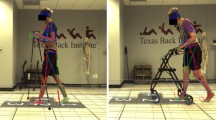Abstract
Study design
Description of technique.
Objectives
Describes the redesign of free-weight-based halo gravity traction wheelchairs and walkers to a spring-based system.
Summary of background data
The treatment of severe pediatric spinal deformities is challenging and associated with significant morbidity. Halo gravity traction (HGT) can be utilized to assist in the correction of severe spinal deformities. A time period of traction may also be used to medically optimize patients prior to surgery. Implementing HGT therapy requires specialized equipment, specially trained hospital staff, as well as significant commitment from caregivers. This study describes the transition from a free weight-based HGT equipment to a spring-based weight system. The new system is expected to decrease the burden of care and improve safety for patients and their families.
Methods
A thorough interview process was carried out to gather data on existing HGT systems. All stakeholders, including orthopedic technicians, nurses, surgeons, patients and their families were asked questions on how to improve the equipment and process. With colleagues at a partner children’s hospital, new HGT wheelchairs and walkers with a spring-based weight system were designed and built.
Results
Spring-based weight HGT wheelchairs and walkers are more economical to build, safer, and easier to operate than free-weight-based systems. A cost analysis found that spring-based systems cost $780 less compared to free weight-based systems. In addition, the new spring-based wheelchairs and walkers are about 50% lighter with improved weight distribution making them safer to operate and easier to transport. There is consensus among surgeons, nurses, and families that the redesigned units are easier to operate.
Conclusions
Spring-based weight HGT systems are economically viable and clinically effective for pre-operative traction for children with severe spinal deformities. They are well tolerated by patients and easy to care for by nursing and surgical staff.
Levels of evidence
III.







Similar content being viewed by others
References
Bogunovic L et al (2013) Preoperative Halo-gravity traction for severe pediatric spinal deformity: complications, radiographic correction and changes in pulmonary function. Spine Deform 1(1):33–39
Bouchoucha S et al (2011) Progressive correction of severe spinal deformities with halo-gravity traction. Acta Orthop Belg 77(4):529–534
McIntosh AL, Ramo BS, Johnston CE (2019) Halo gravity traction for severe pediatric spinal deformity: a clinical concepts review. Spine Deform 7(3):395–403
Watanabe K et al (2010) Efficacy of perioperative halo-gravity traction for treatment of severe scoliosis (%3e/=100 degrees ). J Orthop Sci 15(6):720–730
Yang C et al (2017) Halo-gravity traction in the treatment of severe spinal deformity: a systematic review and meta-analysis. Eur Spine J 26(7):1810–1816
Sponseller PD et al (2008) The use of traction in the treatment of severe spinal deformity. Spine (Phila Pa 1976) 33(21):2305–2309
Iyer S et al (2019) Halo gravity traction can mitigate preoperative risk factors and early surgical complications in complex spine deformity. Spine (Phila Pa 1976) 44(9):629–636
Iyer S et al (2019) The use of Halo gravity traction in the treatment of severe early onset spinal deformity. Spine (Phila Pa 1976) 44(14):E841–e845
LaMont LE et al (2019) Radiographic, pulmonary, and clinical outcomes with halo gravity traction. Spine Deform 7(1):40–46
Garabekyan T et al (2014) The results of preoperative halo-gravity traction in children with severe spinal deformity. J Pediatr Orthop B 23(1):1–5
Park DK et al (2013) The efficacy of preoperative halo-gravity traction in pediatric spinal deformity the effect of traction duration. J Spinal Disord Tech 26(3):146–154
Akbarnia BA, Yazici M, Thompson GH (2010) The growing spine: management of spinal disorders in young children. Springer, New York
Acknowledgements
The authors acknowledge Elise Benefield, Joleen Fischer, Brett Sloan, and David Henning for their help with the implementation of the spring-based weight system for halo gravity traction.
Funding
There was no funding received from the National Institutes of Health (NIH); Welcome Trust; Howard Hughes Medical Institute (HHMI); and other(s). IRB or Research Ethics Committee approval was not necessary for the production of this manuscript.
Author information
Authors and Affiliations
Contributions
All authors contributed to the study conception and design. Material preparation, data collection and analysis were performed by HY, EK, and SG. The first draft of the manuscript was written by HY and all authors commented on previous versions of the manuscript. All authors read and approved the final manuscript.
Corresponding author
Ethics declarations
Conflict of interest
All authors declare that they have no conflict of interest.
Additional information
Publisher's Note
Springer Nature remains neutral with regard to jurisdictional claims in published maps and institutional affiliations.
Rights and permissions
About this article
Cite this article
Yu, H., Kim, E. & Garg, S. Development of a spring-based weight system for halo gravity traction for complex pediatric spinal deformity. Spine Deform 8, 879–884 (2020). https://doi.org/10.1007/s43390-020-00117-1
Received:
Accepted:
Published:
Issue Date:
DOI: https://doi.org/10.1007/s43390-020-00117-1




